BTEC Business Communication Report: Tesco PLC Information Analysis
VerifiedAdded on 2020/06/06
|10
|2712
|330
Report
AI Summary
This report, focusing on business communication within Tesco PLC, explores various aspects of information management and dissemination. It begins by defining different types of business information, including verbal, written, and on-screen formats, and their respective sources and purposes. The report then delves into presenting complex internal business information using a presentation, a short report, and a leaflet, demonstrating diverse communication methods. Corporate communication strategies are examined, evaluating external communications of a product or service. Furthermore, the report addresses legal and ethical considerations, such as the Data Protection Act and the Computer Misuse Act, along with operational issues related to information security and management. Finally, it outlines electronic and non-electronic methods for communicating business information, providing a comprehensive analysis of communication strategies within a business context.
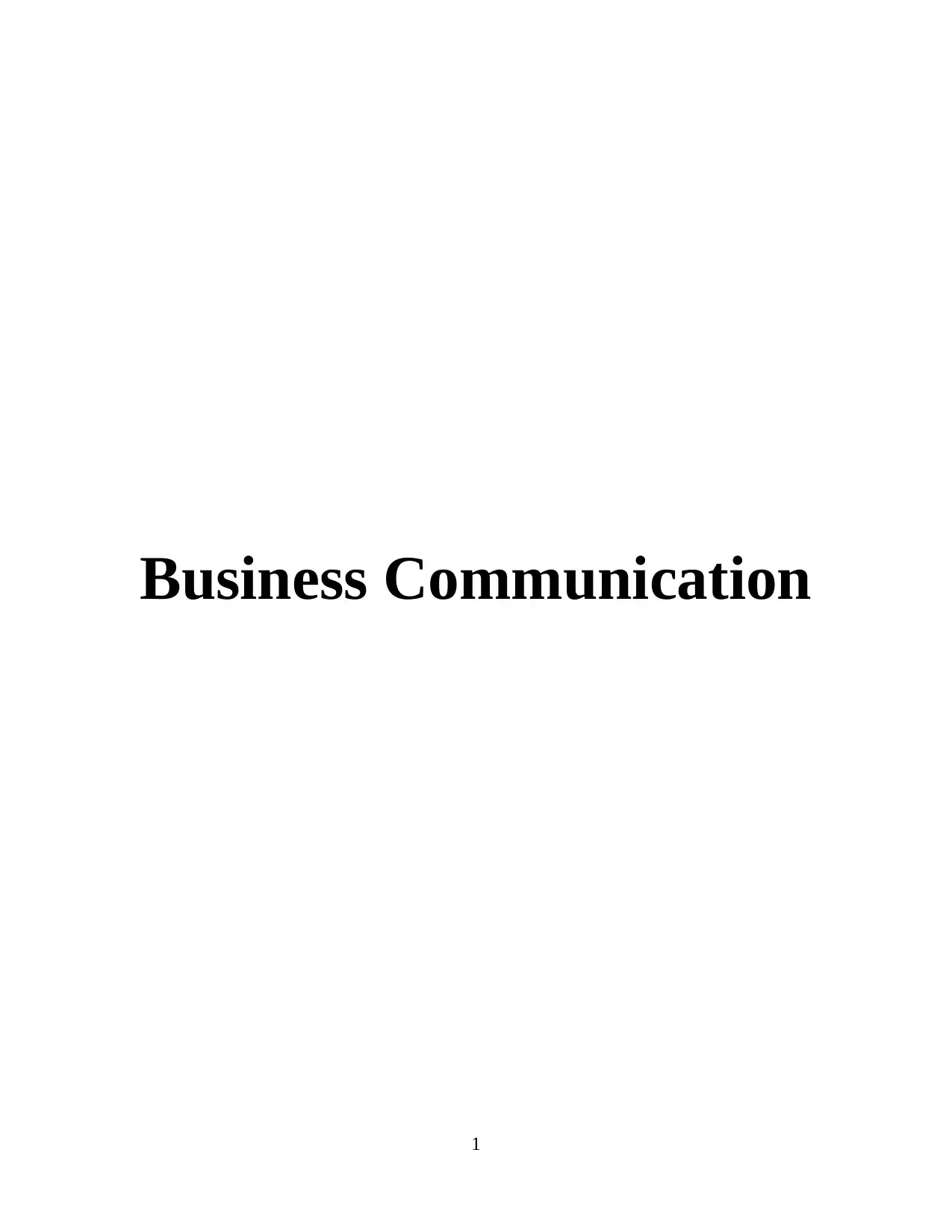
Business Communication
1
1
Paraphrase This Document
Need a fresh take? Get an instant paraphrase of this document with our AI Paraphraser
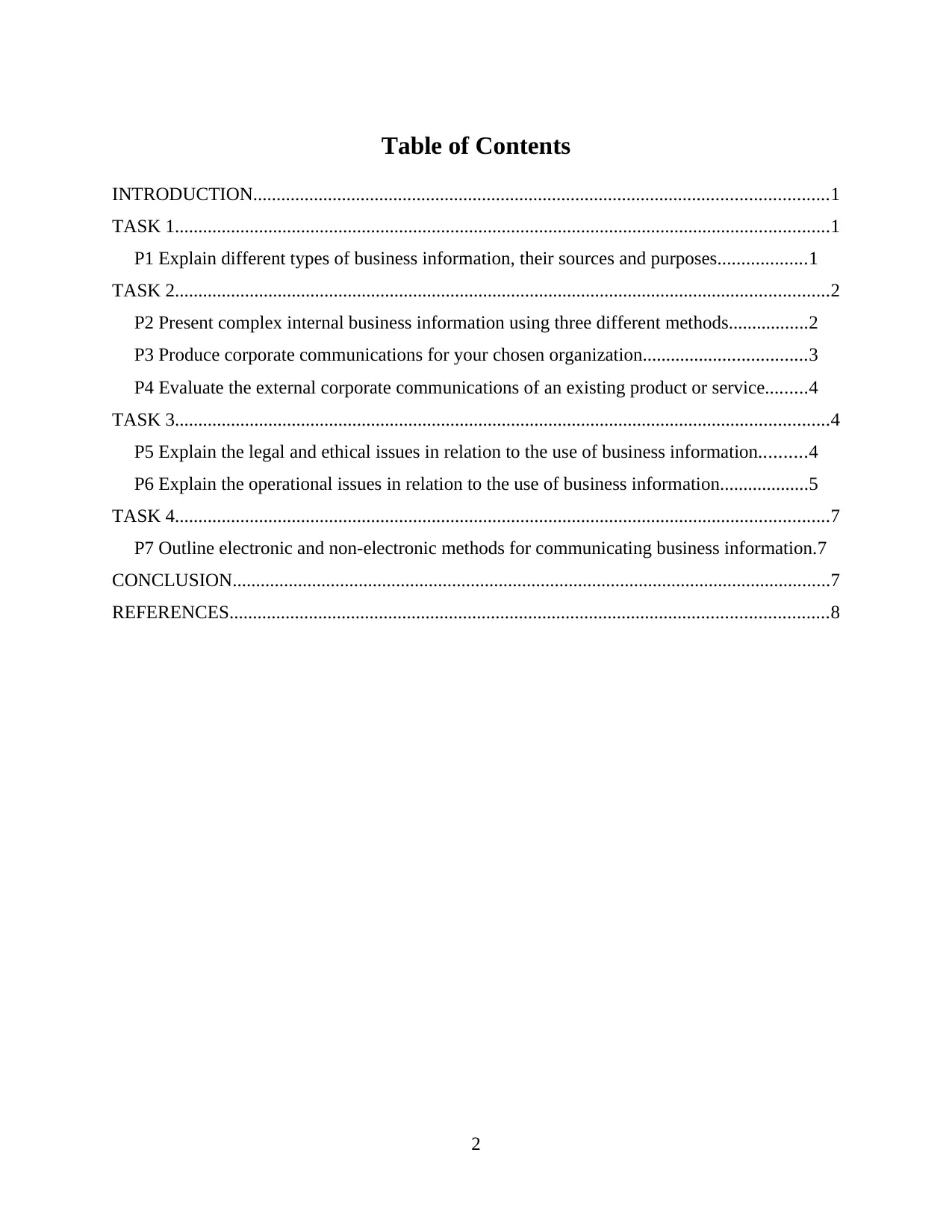
Table of Contents
INTRODUCTION...........................................................................................................................1
TASK 1............................................................................................................................................1
P1 Explain different types of business information, their sources and purposes...................1
TASK 2............................................................................................................................................2
P2 Present complex internal business information using three different methods.................2
P3 Produce corporate communications for your chosen organization...................................3
P4 Evaluate the external corporate communications of an existing product or service.........4
TASK 3............................................................................................................................................4
P5 Explain the legal and ethical issues in relation to the use of business information..........4
P6 Explain the operational issues in relation to the use of business information...................5
TASK 4............................................................................................................................................7
P7 Outline electronic and non-electronic methods for communicating business information.7
CONCLUSION................................................................................................................................7
REFERENCES................................................................................................................................8
2
INTRODUCTION...........................................................................................................................1
TASK 1............................................................................................................................................1
P1 Explain different types of business information, their sources and purposes...................1
TASK 2............................................................................................................................................2
P2 Present complex internal business information using three different methods.................2
P3 Produce corporate communications for your chosen organization...................................3
P4 Evaluate the external corporate communications of an existing product or service.........4
TASK 3............................................................................................................................................4
P5 Explain the legal and ethical issues in relation to the use of business information..........4
P6 Explain the operational issues in relation to the use of business information...................5
TASK 4............................................................................................................................................7
P7 Outline electronic and non-electronic methods for communicating business information.7
CONCLUSION................................................................................................................................7
REFERENCES................................................................................................................................8
2
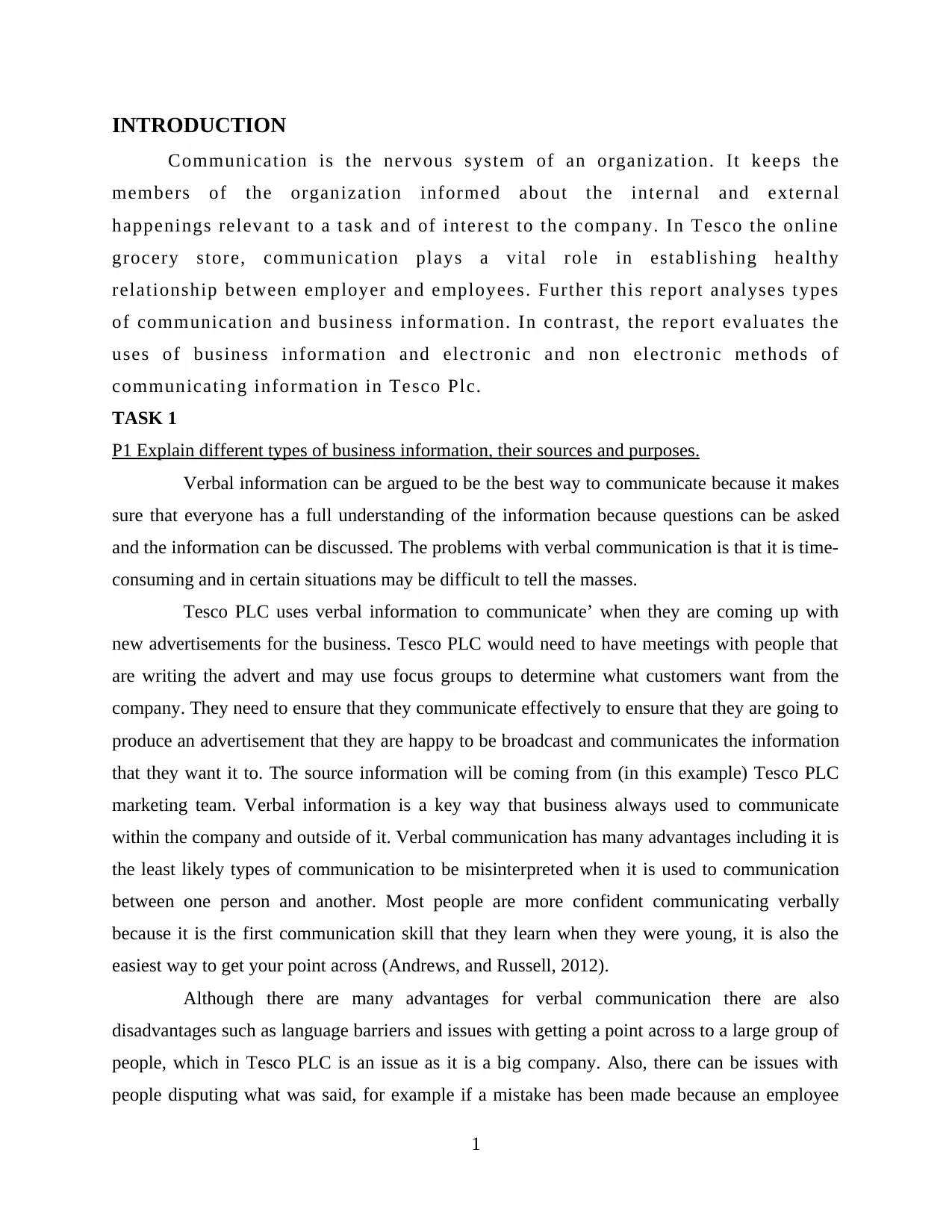
INTRODUCTION
Communication is the nervous system of an organization. It keeps the
members of the organization informed about the internal and external
happenings relevant to a task and of interest to the company. In Tesco the online
grocery store, communication plays a vital role in establishing healthy
relationship between employer and employees. Further this report analyses types
of communication and business information. In contrast, the report evaluates the
uses of business information and electronic and non electronic methods of
communicating information in Tesco Plc.
TASK 1
P1 Explain different types of business information, their sources and purposes.
Verbal information can be argued to be the best way to communicate because it makes
sure that everyone has a full understanding of the information because questions can be asked
and the information can be discussed. The problems with verbal communication is that it is time-
consuming and in certain situations may be difficult to tell the masses.
Tesco PLC uses verbal information to communicate’ when they are coming up with
new advertisements for the business. Tesco PLC would need to have meetings with people that
are writing the advert and may use focus groups to determine what customers want from the
company. They need to ensure that they communicate effectively to ensure that they are going to
produce an advertisement that they are happy to be broadcast and communicates the information
that they want it to. The source information will be coming from (in this example) Tesco PLC
marketing team. Verbal information is a key way that business always used to communicate
within the company and outside of it. Verbal communication has many advantages including it is
the least likely types of communication to be misinterpreted when it is used to communication
between one person and another. Most people are more confident communicating verbally
because it is the first communication skill that they learn when they were young, it is also the
easiest way to get your point across (Andrews, and Russell, 2012).
Although there are many advantages for verbal communication there are also
disadvantages such as language barriers and issues with getting a point across to a large group of
people, which in Tesco PLC is an issue as it is a big company. Also, there can be issues with
people disputing what was said, for example if a mistake has been made because an employee
1
Communication is the nervous system of an organization. It keeps the
members of the organization informed about the internal and external
happenings relevant to a task and of interest to the company. In Tesco the online
grocery store, communication plays a vital role in establishing healthy
relationship between employer and employees. Further this report analyses types
of communication and business information. In contrast, the report evaluates the
uses of business information and electronic and non electronic methods of
communicating information in Tesco Plc.
TASK 1
P1 Explain different types of business information, their sources and purposes.
Verbal information can be argued to be the best way to communicate because it makes
sure that everyone has a full understanding of the information because questions can be asked
and the information can be discussed. The problems with verbal communication is that it is time-
consuming and in certain situations may be difficult to tell the masses.
Tesco PLC uses verbal information to communicate’ when they are coming up with
new advertisements for the business. Tesco PLC would need to have meetings with people that
are writing the advert and may use focus groups to determine what customers want from the
company. They need to ensure that they communicate effectively to ensure that they are going to
produce an advertisement that they are happy to be broadcast and communicates the information
that they want it to. The source information will be coming from (in this example) Tesco PLC
marketing team. Verbal information is a key way that business always used to communicate
within the company and outside of it. Verbal communication has many advantages including it is
the least likely types of communication to be misinterpreted when it is used to communication
between one person and another. Most people are more confident communicating verbally
because it is the first communication skill that they learn when they were young, it is also the
easiest way to get your point across (Andrews, and Russell, 2012).
Although there are many advantages for verbal communication there are also
disadvantages such as language barriers and issues with getting a point across to a large group of
people, which in Tesco PLC is an issue as it is a big company. Also, there can be issues with
people disputing what was said, for example if a mistake has been made because an employee
1
⊘ This is a preview!⊘
Do you want full access?
Subscribe today to unlock all pages.

Trusted by 1+ million students worldwide
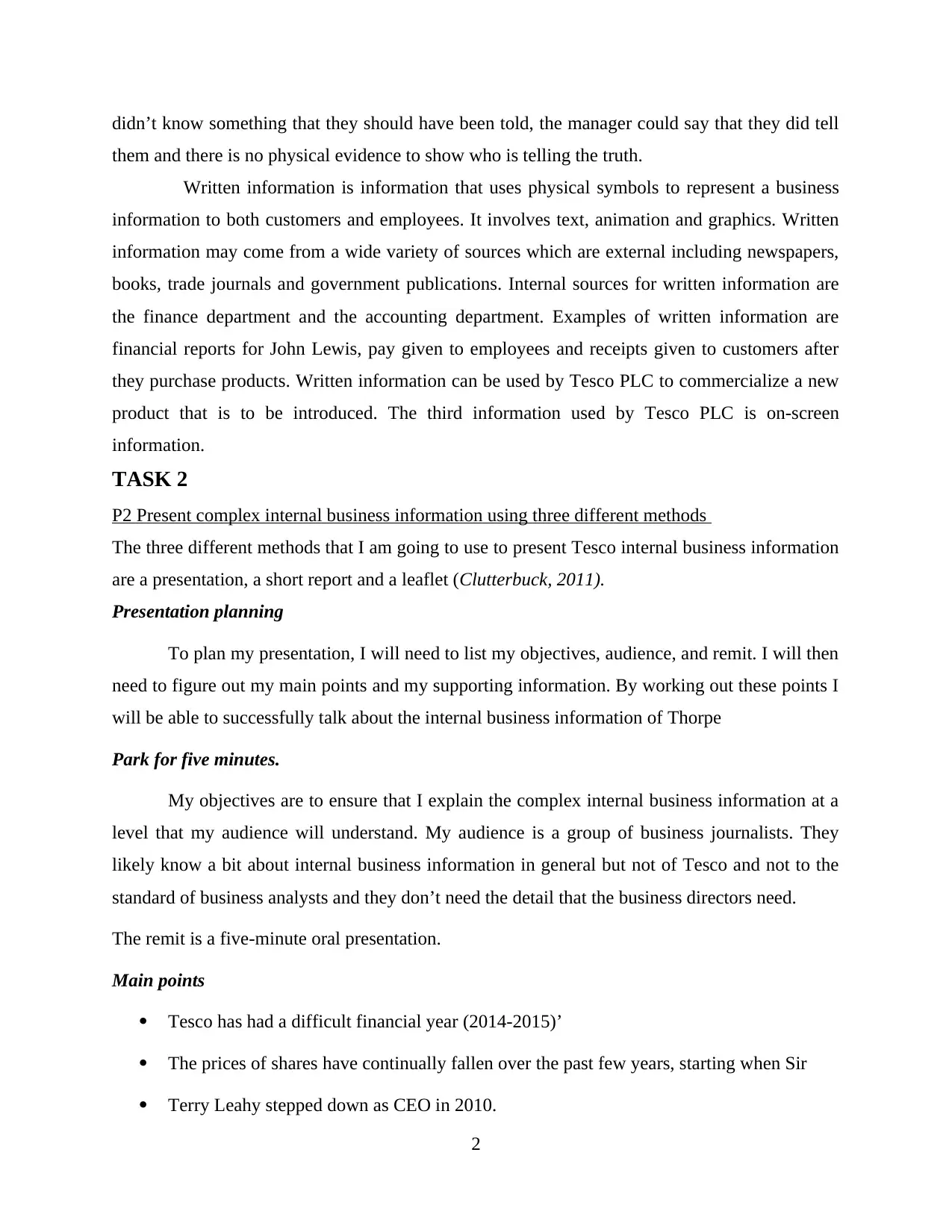
didn’t know something that they should have been told, the manager could say that they did tell
them and there is no physical evidence to show who is telling the truth.
Written information is information that uses physical symbols to represent a business
information to both customers and employees. It involves text, animation and graphics. Written
information may come from a wide variety of sources which are external including newspapers,
books, trade journals and government publications. Internal sources for written information are
the finance department and the accounting department. Examples of written information are
financial reports for John Lewis, pay given to employees and receipts given to customers after
they purchase products. Written information can be used by Tesco PLC to commercialize a new
product that is to be introduced. The third information used by Tesco PLC is on-screen
information.
TASK 2
P2 Present complex internal business information using three different methods
The three different methods that I am going to use to present Tesco internal business information
are a presentation, a short report and a leaflet (Clutterbuck, 2011).
Presentation planning
To plan my presentation, I will need to list my objectives, audience, and remit. I will then
need to figure out my main points and my supporting information. By working out these points I
will be able to successfully talk about the internal business information of Thorpe
Park for five minutes.
My objectives are to ensure that I explain the complex internal business information at a
level that my audience will understand. My audience is a group of business journalists. They
likely know a bit about internal business information in general but not of Tesco and not to the
standard of business analysts and they don’t need the detail that the business directors need.
The remit is a five-minute oral presentation.
Main points
Tesco has had a difficult financial year (2014-2015)’
The prices of shares have continually fallen over the past few years, starting when Sir
Terry Leahy stepped down as CEO in 2010.
2
them and there is no physical evidence to show who is telling the truth.
Written information is information that uses physical symbols to represent a business
information to both customers and employees. It involves text, animation and graphics. Written
information may come from a wide variety of sources which are external including newspapers,
books, trade journals and government publications. Internal sources for written information are
the finance department and the accounting department. Examples of written information are
financial reports for John Lewis, pay given to employees and receipts given to customers after
they purchase products. Written information can be used by Tesco PLC to commercialize a new
product that is to be introduced. The third information used by Tesco PLC is on-screen
information.
TASK 2
P2 Present complex internal business information using three different methods
The three different methods that I am going to use to present Tesco internal business information
are a presentation, a short report and a leaflet (Clutterbuck, 2011).
Presentation planning
To plan my presentation, I will need to list my objectives, audience, and remit. I will then
need to figure out my main points and my supporting information. By working out these points I
will be able to successfully talk about the internal business information of Thorpe
Park for five minutes.
My objectives are to ensure that I explain the complex internal business information at a
level that my audience will understand. My audience is a group of business journalists. They
likely know a bit about internal business information in general but not of Tesco and not to the
standard of business analysts and they don’t need the detail that the business directors need.
The remit is a five-minute oral presentation.
Main points
Tesco has had a difficult financial year (2014-2015)’
The prices of shares have continually fallen over the past few years, starting when Sir
Terry Leahy stepped down as CEO in 2010.
2
Paraphrase This Document
Need a fresh take? Get an instant paraphrase of this document with our AI Paraphraser
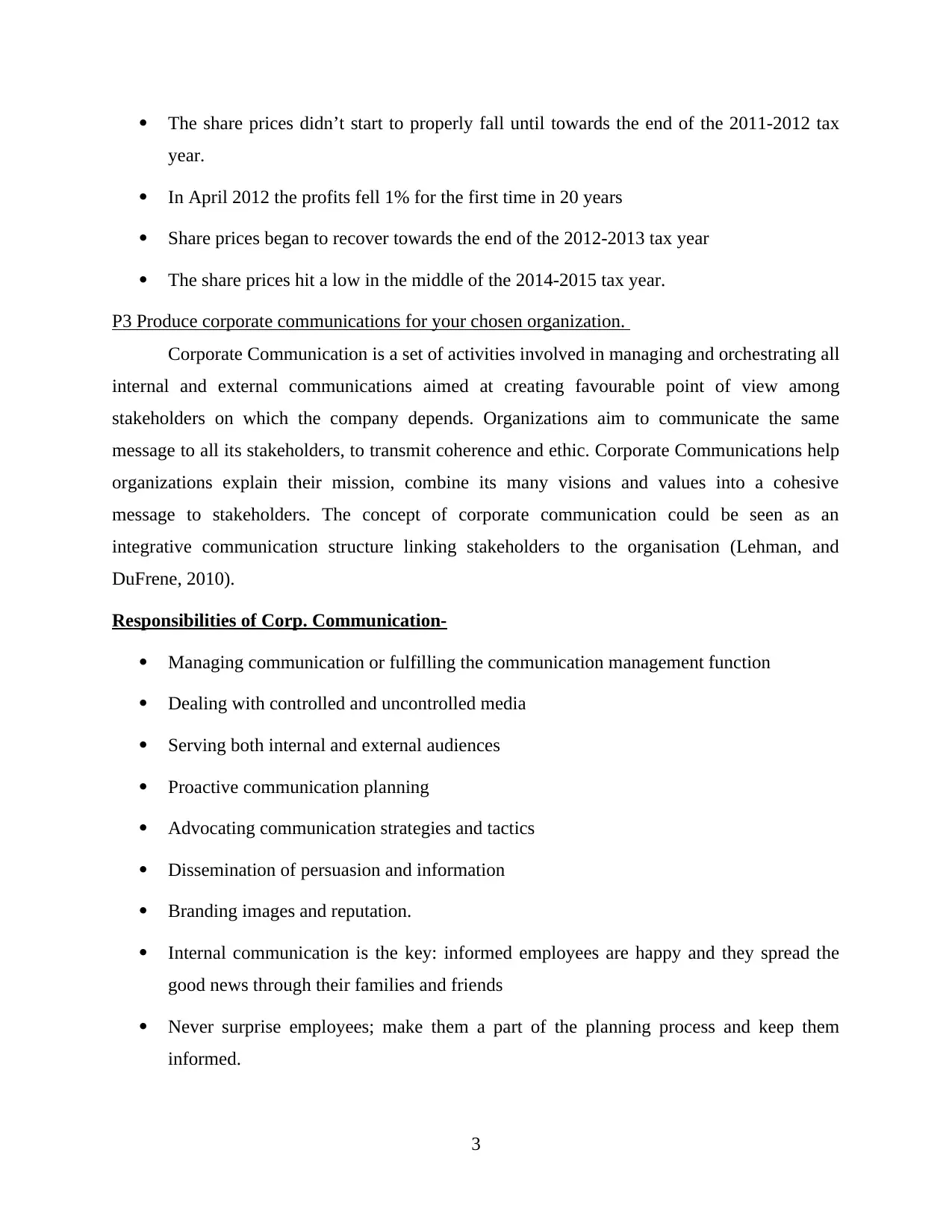
The share prices didn’t start to properly fall until towards the end of the 2011-2012 tax
year.
In April 2012 the profits fell 1% for the first time in 20 years
Share prices began to recover towards the end of the 2012-2013 tax year
The share prices hit a low in the middle of the 2014-2015 tax year.
P3 Produce corporate communications for your chosen organization.
Corporate Communication is a set of activities involved in managing and orchestrating all
internal and external communications aimed at creating favourable point of view among
stakeholders on which the company depends. Organizations aim to communicate the same
message to all its stakeholders, to transmit coherence and ethic. Corporate Communications help
organizations explain their mission, combine its many visions and values into a cohesive
message to stakeholders. The concept of corporate communication could be seen as an
integrative communication structure linking stakeholders to the organisation (Lehman, and
DuFrene, 2010).
Responsibilities of Corp. Communication-
Managing communication or fulfilling the communication management function
Dealing with controlled and uncontrolled media
Serving both internal and external audiences
Proactive communication planning
Advocating communication strategies and tactics
Dissemination of persuasion and information
Branding images and reputation.
Internal communication is the key: informed employees are happy and they spread the
good news through their families and friends
Never surprise employees; make them a part of the planning process and keep them
informed.
3
year.
In April 2012 the profits fell 1% for the first time in 20 years
Share prices began to recover towards the end of the 2012-2013 tax year
The share prices hit a low in the middle of the 2014-2015 tax year.
P3 Produce corporate communications for your chosen organization.
Corporate Communication is a set of activities involved in managing and orchestrating all
internal and external communications aimed at creating favourable point of view among
stakeholders on which the company depends. Organizations aim to communicate the same
message to all its stakeholders, to transmit coherence and ethic. Corporate Communications help
organizations explain their mission, combine its many visions and values into a cohesive
message to stakeholders. The concept of corporate communication could be seen as an
integrative communication structure linking stakeholders to the organisation (Lehman, and
DuFrene, 2010).
Responsibilities of Corp. Communication-
Managing communication or fulfilling the communication management function
Dealing with controlled and uncontrolled media
Serving both internal and external audiences
Proactive communication planning
Advocating communication strategies and tactics
Dissemination of persuasion and information
Branding images and reputation.
Internal communication is the key: informed employees are happy and they spread the
good news through their families and friends
Never surprise employees; make them a part of the planning process and keep them
informed.
3
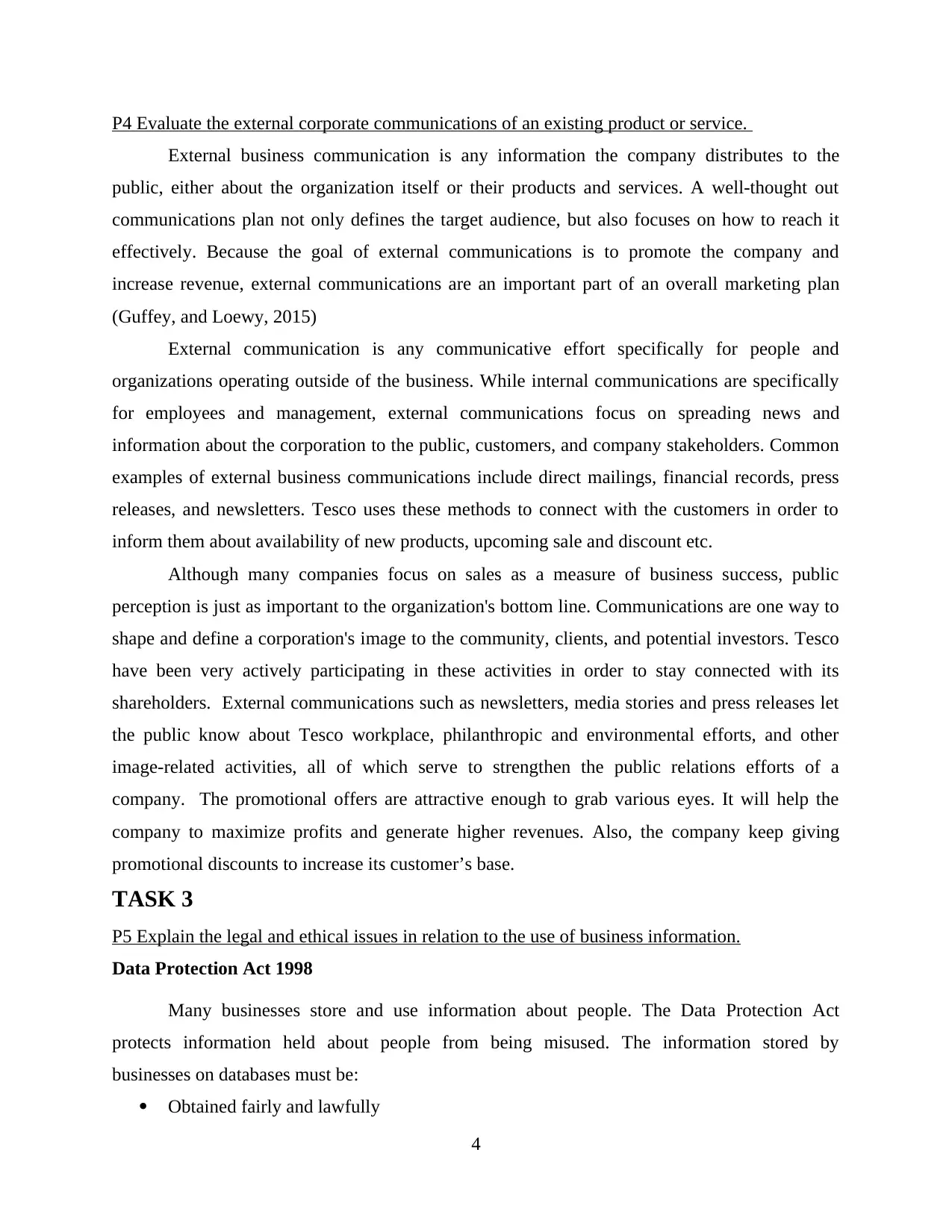
P4 Evaluate the external corporate communications of an existing product or service.
External business communication is any information the company distributes to the
public, either about the organization itself or their products and services. A well-thought out
communications plan not only defines the target audience, but also focuses on how to reach it
effectively. Because the goal of external communications is to promote the company and
increase revenue, external communications are an important part of an overall marketing plan
(Guffey, and Loewy, 2015)
External communication is any communicative effort specifically for people and
organizations operating outside of the business. While internal communications are specifically
for employees and management, external communications focus on spreading news and
information about the corporation to the public, customers, and company stakeholders. Common
examples of external business communications include direct mailings, financial records, press
releases, and newsletters. Tesco uses these methods to connect with the customers in order to
inform them about availability of new products, upcoming sale and discount etc.
Although many companies focus on sales as a measure of business success, public
perception is just as important to the organization's bottom line. Communications are one way to
shape and define a corporation's image to the community, clients, and potential investors. Tesco
have been very actively participating in these activities in order to stay connected with its
shareholders. External communications such as newsletters, media stories and press releases let
the public know about Tesco workplace, philanthropic and environmental efforts, and other
image-related activities, all of which serve to strengthen the public relations efforts of a
company. The promotional offers are attractive enough to grab various eyes. It will help the
company to maximize profits and generate higher revenues. Also, the company keep giving
promotional discounts to increase its customer’s base.
TASK 3
P5 Explain the legal and ethical issues in relation to the use of business information.
Data Protection Act 1998
Many businesses store and use information about people. The Data Protection Act
protects information held about people from being misused. The information stored by
businesses on databases must be:
Obtained fairly and lawfully
4
External business communication is any information the company distributes to the
public, either about the organization itself or their products and services. A well-thought out
communications plan not only defines the target audience, but also focuses on how to reach it
effectively. Because the goal of external communications is to promote the company and
increase revenue, external communications are an important part of an overall marketing plan
(Guffey, and Loewy, 2015)
External communication is any communicative effort specifically for people and
organizations operating outside of the business. While internal communications are specifically
for employees and management, external communications focus on spreading news and
information about the corporation to the public, customers, and company stakeholders. Common
examples of external business communications include direct mailings, financial records, press
releases, and newsletters. Tesco uses these methods to connect with the customers in order to
inform them about availability of new products, upcoming sale and discount etc.
Although many companies focus on sales as a measure of business success, public
perception is just as important to the organization's bottom line. Communications are one way to
shape and define a corporation's image to the community, clients, and potential investors. Tesco
have been very actively participating in these activities in order to stay connected with its
shareholders. External communications such as newsletters, media stories and press releases let
the public know about Tesco workplace, philanthropic and environmental efforts, and other
image-related activities, all of which serve to strengthen the public relations efforts of a
company. The promotional offers are attractive enough to grab various eyes. It will help the
company to maximize profits and generate higher revenues. Also, the company keep giving
promotional discounts to increase its customer’s base.
TASK 3
P5 Explain the legal and ethical issues in relation to the use of business information.
Data Protection Act 1998
Many businesses store and use information about people. The Data Protection Act
protects information held about people from being misused. The information stored by
businesses on databases must be:
Obtained fairly and lawfully
4
⊘ This is a preview!⊘
Do you want full access?
Subscribe today to unlock all pages.

Trusted by 1+ million students worldwide
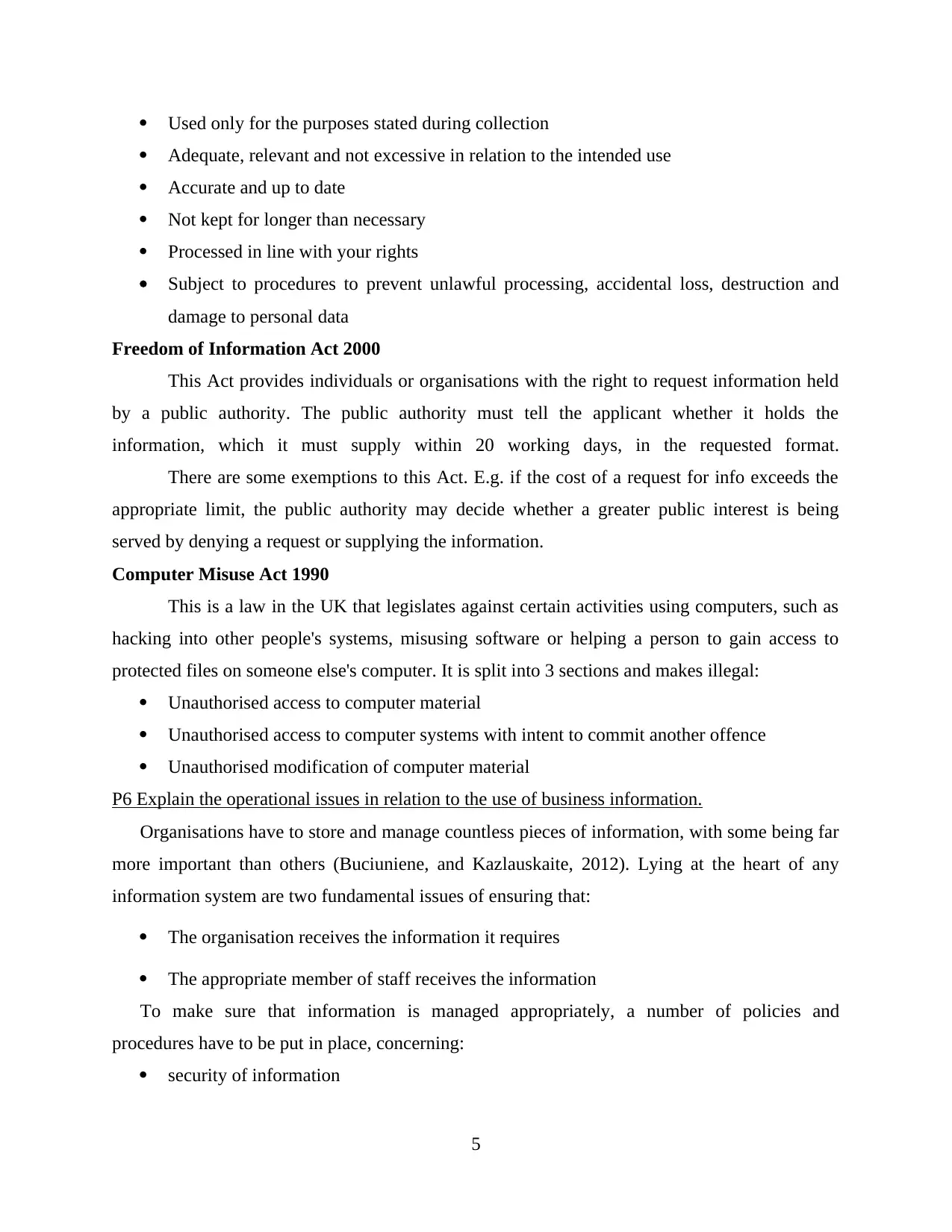
Used only for the purposes stated during collection
Adequate, relevant and not excessive in relation to the intended use
Accurate and up to date
Not kept for longer than necessary
Processed in line with your rights
Subject to procedures to prevent unlawful processing, accidental loss, destruction and
damage to personal data
Freedom of Information Act 2000
This Act provides individuals or organisations with the right to request information held
by a public authority. The public authority must tell the applicant whether it holds the
information, which it must supply within 20 working days, in the requested format.
There are some exemptions to this Act. E.g. if the cost of a request for info exceeds the
appropriate limit, the public authority may decide whether a greater public interest is being
served by denying a request or supplying the information.
Computer Misuse Act 1990
This is a law in the UK that legislates against certain activities using computers, such as
hacking into other people's systems, misusing software or helping a person to gain access to
protected files on someone else's computer. It is split into 3 sections and makes illegal:
Unauthorised access to computer material
Unauthorised access to computer systems with intent to commit another offence
Unauthorised modification of computer material
P6 Explain the operational issues in relation to the use of business information.
Organisations have to store and manage countless pieces of information, with some being far
more important than others (Buciuniene, and Kazlauskaite, 2012). Lying at the heart of any
information system are two fundamental issues of ensuring that:
The organisation receives the information it requires
The appropriate member of staff receives the information
To make sure that information is managed appropriately, a number of policies and
procedures have to be put in place, concerning:
security of information
5
Adequate, relevant and not excessive in relation to the intended use
Accurate and up to date
Not kept for longer than necessary
Processed in line with your rights
Subject to procedures to prevent unlawful processing, accidental loss, destruction and
damage to personal data
Freedom of Information Act 2000
This Act provides individuals or organisations with the right to request information held
by a public authority. The public authority must tell the applicant whether it holds the
information, which it must supply within 20 working days, in the requested format.
There are some exemptions to this Act. E.g. if the cost of a request for info exceeds the
appropriate limit, the public authority may decide whether a greater public interest is being
served by denying a request or supplying the information.
Computer Misuse Act 1990
This is a law in the UK that legislates against certain activities using computers, such as
hacking into other people's systems, misusing software or helping a person to gain access to
protected files on someone else's computer. It is split into 3 sections and makes illegal:
Unauthorised access to computer material
Unauthorised access to computer systems with intent to commit another offence
Unauthorised modification of computer material
P6 Explain the operational issues in relation to the use of business information.
Organisations have to store and manage countless pieces of information, with some being far
more important than others (Buciuniene, and Kazlauskaite, 2012). Lying at the heart of any
information system are two fundamental issues of ensuring that:
The organisation receives the information it requires
The appropriate member of staff receives the information
To make sure that information is managed appropriately, a number of policies and
procedures have to be put in place, concerning:
security of information
5
Paraphrase This Document
Need a fresh take? Get an instant paraphrase of this document with our AI Paraphraser
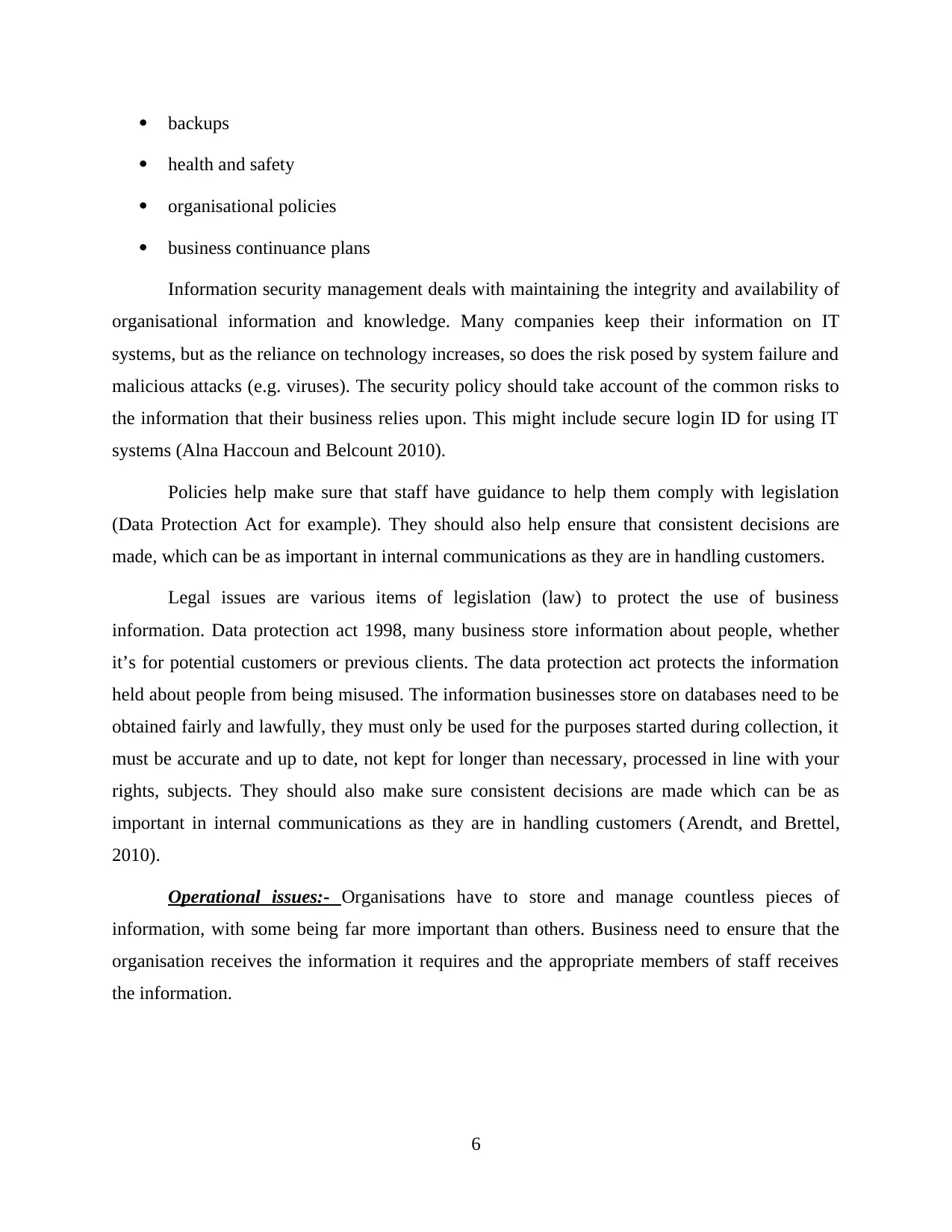
backups
health and safety
organisational policies
business continuance plans
Information security management deals with maintaining the integrity and availability of
organisational information and knowledge. Many companies keep their information on IT
systems, but as the reliance on technology increases, so does the risk posed by system failure and
malicious attacks (e.g. viruses). The security policy should take account of the common risks to
the information that their business relies upon. This might include secure login ID for using IT
systems (Alna Haccoun and Belcount 2010).
Policies help make sure that staff have guidance to help them comply with legislation
(Data Protection Act for example). They should also help ensure that consistent decisions are
made, which can be as important in internal communications as they are in handling customers.
Legal issues are various items of legislation (law) to protect the use of business
information. Data protection act 1998, many business store information about people, whether
it’s for potential customers or previous clients. The data protection act protects the information
held about people from being misused. The information businesses store on databases need to be
obtained fairly and lawfully, they must only be used for the purposes started during collection, it
must be accurate and up to date, not kept for longer than necessary, processed in line with your
rights, subjects. They should also make sure consistent decisions are made which can be as
important in internal communications as they are in handling customers (Arendt, and Brettel,
2010).
Operational issues:- Organisations have to store and manage countless pieces of
information, with some being far more important than others. Business need to ensure that the
organisation receives the information it requires and the appropriate members of staff receives
the information.
6
health and safety
organisational policies
business continuance plans
Information security management deals with maintaining the integrity and availability of
organisational information and knowledge. Many companies keep their information on IT
systems, but as the reliance on technology increases, so does the risk posed by system failure and
malicious attacks (e.g. viruses). The security policy should take account of the common risks to
the information that their business relies upon. This might include secure login ID for using IT
systems (Alna Haccoun and Belcount 2010).
Policies help make sure that staff have guidance to help them comply with legislation
(Data Protection Act for example). They should also help ensure that consistent decisions are
made, which can be as important in internal communications as they are in handling customers.
Legal issues are various items of legislation (law) to protect the use of business
information. Data protection act 1998, many business store information about people, whether
it’s for potential customers or previous clients. The data protection act protects the information
held about people from being misused. The information businesses store on databases need to be
obtained fairly and lawfully, they must only be used for the purposes started during collection, it
must be accurate and up to date, not kept for longer than necessary, processed in line with your
rights, subjects. They should also make sure consistent decisions are made which can be as
important in internal communications as they are in handling customers (Arendt, and Brettel,
2010).
Operational issues:- Organisations have to store and manage countless pieces of
information, with some being far more important than others. Business need to ensure that the
organisation receives the information it requires and the appropriate members of staff receives
the information.
6
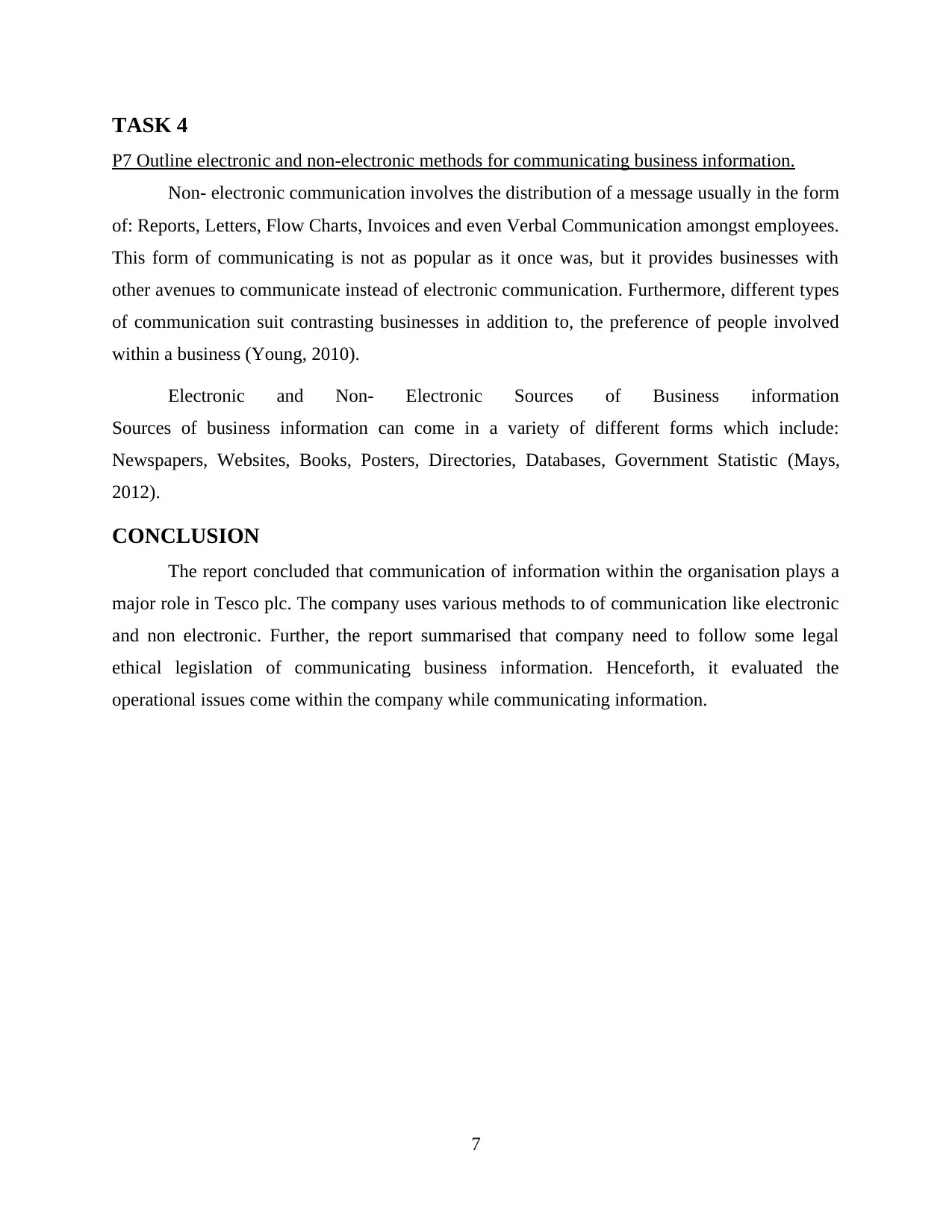
TASK 4
P7 Outline electronic and non-electronic methods for communicating business information.
Non- electronic communication involves the distribution of a message usually in the form
of: Reports, Letters, Flow Charts, Invoices and even Verbal Communication amongst employees.
This form of communicating is not as popular as it once was, but it provides businesses with
other avenues to communicate instead of electronic communication. Furthermore, different types
of communication suit contrasting businesses in addition to, the preference of people involved
within a business (Young, 2010).
Electronic and Non- Electronic Sources of Business information
Sources of business information can come in a variety of different forms which include:
Newspapers, Websites, Books, Posters, Directories, Databases, Government Statistic (Mays,
2012).
CONCLUSION
The report concluded that communication of information within the organisation plays a
major role in Tesco plc. The company uses various methods to of communication like electronic
and non electronic. Further, the report summarised that company need to follow some legal
ethical legislation of communicating business information. Henceforth, it evaluated the
operational issues come within the company while communicating information.
7
P7 Outline electronic and non-electronic methods for communicating business information.
Non- electronic communication involves the distribution of a message usually in the form
of: Reports, Letters, Flow Charts, Invoices and even Verbal Communication amongst employees.
This form of communicating is not as popular as it once was, but it provides businesses with
other avenues to communicate instead of electronic communication. Furthermore, different types
of communication suit contrasting businesses in addition to, the preference of people involved
within a business (Young, 2010).
Electronic and Non- Electronic Sources of Business information
Sources of business information can come in a variety of different forms which include:
Newspapers, Websites, Books, Posters, Directories, Databases, Government Statistic (Mays,
2012).
CONCLUSION
The report concluded that communication of information within the organisation plays a
major role in Tesco plc. The company uses various methods to of communication like electronic
and non electronic. Further, the report summarised that company need to follow some legal
ethical legislation of communicating business information. Henceforth, it evaluated the
operational issues come within the company while communicating information.
7
⊘ This is a preview!⊘
Do you want full access?
Subscribe today to unlock all pages.

Trusted by 1+ million students worldwide

REFERENCES
Books and journals
Alna S., Haccoun R. and Belcount M., 2010. Managing Performance Through Training and
Development. Cengage Learning publises.
Andrews, G. and Russell, M., 2012. Employability skills development: strategy, evaluation and
impact. Higher Education, Skills and Work-based Learning. 2(1). pp.33-44.
Arendt, S. and Brettel, M., 2010. Understanding the influence of corporate social responsibility
on corporate identity, image, and firm performance. Management Decision. 48(10).
pp.1469 – 1492
Buciuniene, I. and Kazlauskaite, R., 2012. The linkage between HRM, CSR and performance
outcomes. Baltic Journal of Management. 7(1). pp.5-24.
Clutterbuck, D., 2011. The communicating company. Journal of Communication Management.
6(1). pp.70-76.
Guffey, M. and Loewy, D., 2015. Essentials of Business Communication. Cengage Learning.
Lehman, C. and DuFrene, D., 2010. Business Communication. Cengage Learning.
Mays, M., 2012. Chapter 12 Misbehavior in Online Testing, in Laura A. Wankel, Charles
Wankel . Misbehavior Online in Higher Education. Emerald Group Publishing Limited.
pp.243 - 260.
Young, P., 2010. International Communications Strategy: Developments in Cross‐cultural
Communications, PR and Social Media. Journal of Communication Management. 14(4).
pp. 388-390.
8
Books and journals
Alna S., Haccoun R. and Belcount M., 2010. Managing Performance Through Training and
Development. Cengage Learning publises.
Andrews, G. and Russell, M., 2012. Employability skills development: strategy, evaluation and
impact. Higher Education, Skills and Work-based Learning. 2(1). pp.33-44.
Arendt, S. and Brettel, M., 2010. Understanding the influence of corporate social responsibility
on corporate identity, image, and firm performance. Management Decision. 48(10).
pp.1469 – 1492
Buciuniene, I. and Kazlauskaite, R., 2012. The linkage between HRM, CSR and performance
outcomes. Baltic Journal of Management. 7(1). pp.5-24.
Clutterbuck, D., 2011. The communicating company. Journal of Communication Management.
6(1). pp.70-76.
Guffey, M. and Loewy, D., 2015. Essentials of Business Communication. Cengage Learning.
Lehman, C. and DuFrene, D., 2010. Business Communication. Cengage Learning.
Mays, M., 2012. Chapter 12 Misbehavior in Online Testing, in Laura A. Wankel, Charles
Wankel . Misbehavior Online in Higher Education. Emerald Group Publishing Limited.
pp.243 - 260.
Young, P., 2010. International Communications Strategy: Developments in Cross‐cultural
Communications, PR and Social Media. Journal of Communication Management. 14(4).
pp. 388-390.
8
1 out of 10
Related Documents
Your All-in-One AI-Powered Toolkit for Academic Success.
+13062052269
info@desklib.com
Available 24*7 on WhatsApp / Email
![[object Object]](/_next/static/media/star-bottom.7253800d.svg)
Unlock your academic potential
Copyright © 2020–2025 A2Z Services. All Rights Reserved. Developed and managed by ZUCOL.





